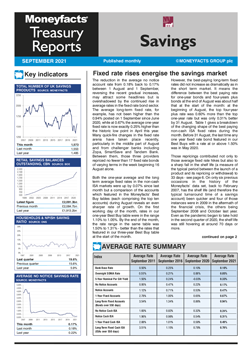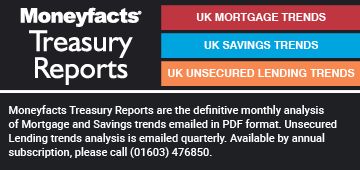Rachel Springall, Finance Expert at Moneyfacts, said:
“Vigorous competition from savings providers has resulted in the average shelf life for a fixed rate bond falling to 33 days on average and all fixed bond and fixed ISA rates rose month-on-month. Average rates on fixed bonds and ISAs are now at their highest level all year, which will be great news to savers. However, savings providers will need to act quickly to react to the notable flux of rate rises in the market and indeed any demand from savers looking to fix their cash for a competitive return.
“Stability and progress to improve competition and choice within the savings market should be encouraged, however, not all interest rates are rising. The average no notice rate fell month-on-month and the average no notice ISA and notice ISA remained unchanged, with the latter standing at a record low. Clearly, there is far less competition between different sectors of the market – particularly on accounts where savers could withdraw their cash overnight. Savers would then be wise not to assume all rates have risen and be sure to compare carefully.
“Savers who feel uneasy in locking their money away for a year or more may find notice accounts as an alternative between fixed and easy access accounts, especially as notice rates are on the rise. Month-on-month the average notice rate rose for the fifth month running to 0.47% and is at its highest all year. There are many challenger banks within this arena, as there are in the fixed bond market, but where activity is lacking is within the ISA market, which could do with a healthy injection of competition. However, in a low-interest-rate environment and with savers utilising the Personal Savings Allowance, it's understandable if some savers overlook ISAs altogether.
“Where savers feel confident to invest will require their judgement on access, and so far, the signs for 2021 point towards easy access accounts being the most favourable. Indeed, according to the Bank of England, the inflow into sight deposits during July was just over £7bn, and almost £72bn so far this year. As interest rates continue to change, savers and providers alike will need to act with pace to keep on top of rate adjustments and demand.”
Rachel Springall, Finance Expert at Moneyfacts, said:
“Vigorous competition from savings providers has resulted in the average shelf life for a fixed rate bond falling to 33 days on average and all fixed bond and fixed ISA rates rose month-on-month. Average rates on fixed bonds and ISAs are now at their highest level all year, which will be great news to savers. However, savings providers will need to act quickly to react to the notable flux of rate rises in the market and indeed any demand from savers looking to fix their cash for a competitive return.
“Stability and progress to improve competition and choice within the savings market should be encouraged, however, not all interest rates are rising. The average no notice rate fell month-on-month and the average no notice ISA and notice ISA remained unchanged, with the latter standing at a record low. Clearly, there is far less competition between different sectors of the market – particularly on accounts where savers could withdraw their cash overnight. Savers would then be wise not to assume all rates have risen and be sure to compare carefully.
“Savers who feel uneasy in locking their money away for a year or more may find notice accounts as an alternative between fixed and easy access accounts, especially as notice rates are on the rise. Month-on-month the average notice rate rose for the fifth month running to 0.47% and is at its highest all year. There are many challenger banks within this arena, as there are in the fixed bond market, but where activity is lacking is within the ISA market, which could do with a healthy injection of competition. However, in a low-interest-rate environment and with savers utilising the Personal Savings Allowance, it's understandable if some savers overlook ISAs altogether.
“Where savers feel confident to invest will require their judgement on access, and so far, the signs for 2021 point towards easy access accounts being the most favourable. Indeed, according to the Bank of England, the inflow into sight deposits during July was just over £7bn, and almost £72bn so far this year. As interest rates continue to change, savers and providers alike will need to act with pace to keep on top of rate adjustments and demand.”











